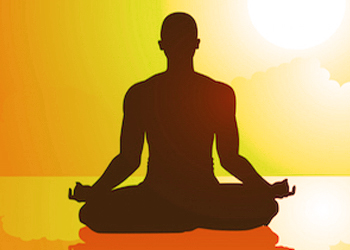Archaeological evidence suggests that yoga was practiced in ancient India since 3000 BC. Many great personalities (Jain or not) like Patanjali, Acharya Amitagati, and Acharya Umasvami have strongly believed yoga to be a path for liberation. Yoga is also considered as a science that helps a person to communicate with his/her body, mind, and soul, gaining complete control over physical, mental, and intellectual energies, to live a positive life.
 There are a few misconceptions which consider yoga to be a part of Hindu religion, just sitting in difficult postures for hours at a time or even that yoga only brings peace and happiness. In fact, in Jain tradition Yoga is any activity which helps the soul achieve liberation. Along with peace, the happiness it also aims for awareness, purification of mind, and liberation. Even walking, staying, eating, earning or any activity if done with full awareness of the self and according to the guidance shown by Tirthankara then it is considered as Yoga.
There are a few misconceptions which consider yoga to be a part of Hindu religion, just sitting in difficult postures for hours at a time or even that yoga only brings peace and happiness. In fact, in Jain tradition Yoga is any activity which helps the soul achieve liberation. Along with peace, the happiness it also aims for awareness, purification of mind, and liberation. Even walking, staying, eating, earning or any activity if done with full awareness of the self and according to the guidance shown by Tirthankara then it is considered as Yoga.
We have been given a body through which the soul can realize itself, and it is our duty to treat the body with respect. It is said that karmic matter flows into the soul through the channel or medium of activity. If such activity is accompanied by auspicious intention, it becomes the cause of Punya (merits); if it is accompanied by inauspicious intention, it becomes the cause of Paap (demerit).
Indian tradition defines four primary paths of yoga which lead the worldly soul to liberation: Bhakti Yoga, includes chanting, singing, and praying which develops humility within and dissolves ego. It should be practiced mainly by emotionally oriented people. Jnan Yoga, allows one to spiritually discriminate between what is real and what is unreal or illusion (Maya) in the universe. It requires the initial guidance of a guru to practice this form of yoga as it involves study, thinking, direct inquiry, and contemplation. Karma Yoga involves selfless service for the benefit of all living beings like social work, ecology, environmental protection, education, animal protection, and more. Ashtanga Yoga concentrates on the subtle body for the liberation of the body and soul. It is the science of physical and mental control.
A person does not need to be religious or in search of God to practice yoga. One only needs to have a desire to free oneself from the bonds that restrict oneself from being truly free. Once these bonds are broken by uninterrupted practice and devotion, one realizes the true human potential, the true reality, and the God/Self within. A person can attain total freedom or realize God within by using any of the four paths. However, at the final liberating state, all paths merge, meaning the ultimate spiritual quality and characteristics of all liberated souls are the same.
Shri Patanjali and Shri Haribhadra-Suri propounded Ashtanga yoga as a path to attain liberation. Patanjali has enumerated eight steps of Ashtanga Yoga:
concentrates on the subtle body for liberation of body and soul. It is the science of physical and mental control.
- Yama (Restraints)
- Niyama (Observances – Individual Discipline)
- Asana (Physical Exercise)
- Pranayama (Rhythmic Breathing)
- Pratyahara (Detachment of Mind)
- Dharana (Complete Absorption of the Mind on a Single Task)
- Dhyana (Meditation)
- Samadhi(Total Absorption or Super Conscious State)
The first five steps of the Ashtanga Yoga are only for preparations of the mind for yoga, which is concentration. The last three steps constitute the application of concentration.
A person does not need to be religious or in search of God to practice yoga. One only needs to have a desire to free oneself from the bonds that restrict oneself from being truly free. Once these bonds are broken by uninterrupted practice and devotion, one realizes the true human potential, the true reality, and the God/Self within. A person can attain total freedom or realize God within using any of the four paths. However, at the final liberating state all paths merge, meaning the ultimate spiritual quality and characteristics of all liberated souls are the same.
Source: https://www.jainlexicon.com/dashboard/word/925
Academic Advisor: Dr.Jitendra B.Shah, Ahmedabad
General Editor: Dilip V. Shah, Philadelphia
co-edited by : Hiloni Doshi

